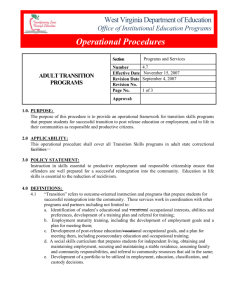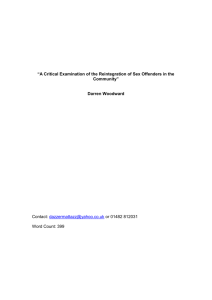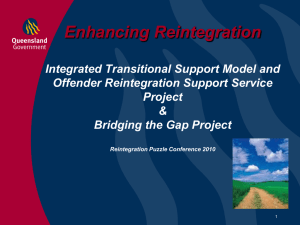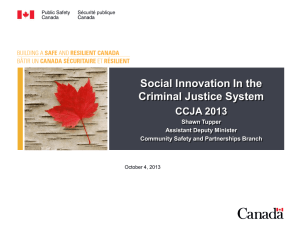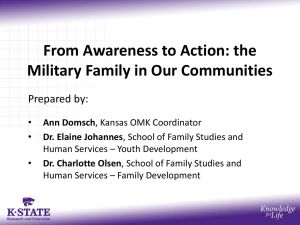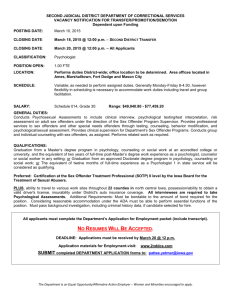Federal Community Corrections Strategy
advertisement
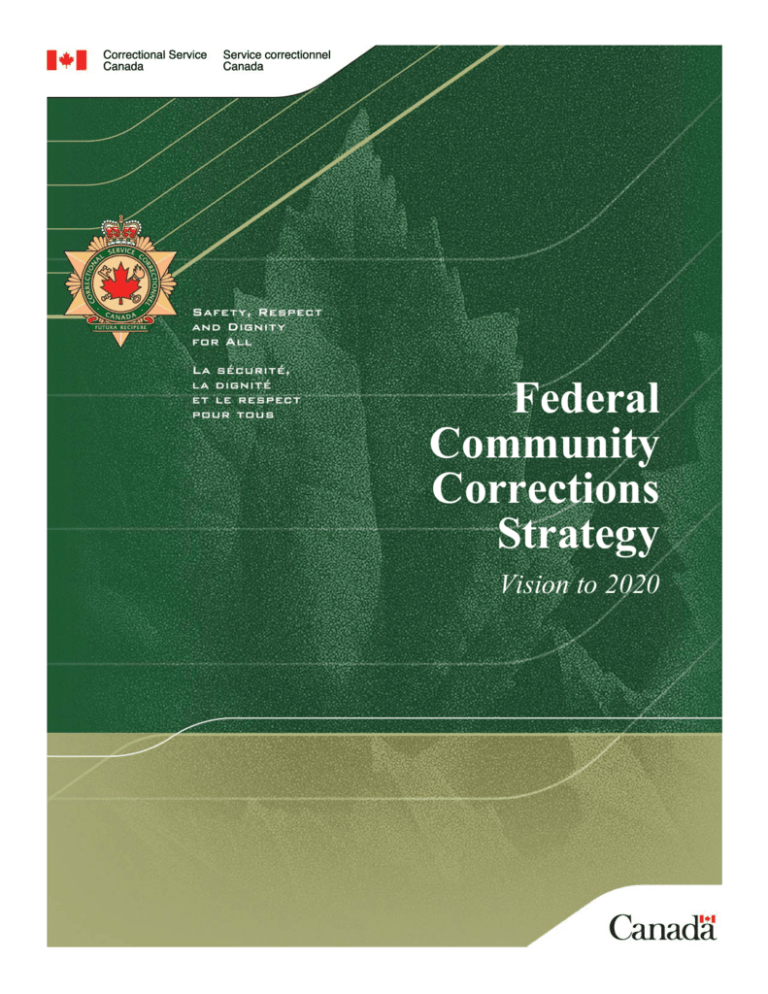
Federal Community Corrections Strategy Vision to 2020 FEDERAL COMMUNITY CORRECTIONS STRATEGY - VISION TO 2020 TABLE OF CONTENTS PART I ........................................................................................................................................... 3 Introduction ......................................................................................................................... 3 Legislative Context ............................................................................................................. 4 PART II.......................................................................................................................................... 5 Defining Community Corrections....................................................................................... 5 Vision Statement ................................................................................................................. 5 Strategic Principles ............................................................................................................. 6 1: Community reintegration begins at intake ......................................................... 6 2: Community reintegration requires dynamic assessment and intervention ........ 7 3: Community reintegration is achieved through collaboration ............................. 7 4: Community reintegration is measured by public safety results ......................... 9 5: Community reintegration is enhanced through engagement and communication ................................................................................................................................. 9 Moving Forward ............................................................................................................... 10 2 FEDERAL COMMUNITY CORRECTIONS STRATEGY - VISION TO 2020 PART I INTRODUCTION For the Correctional Service of Canada (CSC), public safety is paramount. CSC and partners, although having differing roles, work together to create safe communities by forging strong networks to support offender reintegration. These partnerships respect and build on each others’ contributions and strengths, as well as explore means for sharing information and tools with a mutual focus on enhancing the safety of Canadian communities. In November 2009, the Commissioner of CSC made a commitment to partners to develop a federal strategy for community corrections. A planning meeting was held with partners in March 2010 and, following that meeting, a Project Charter was created to guide the development of this Strategy. The Strategy would be developed in collaboration with partners and stakeholders including staff, offenders, victims, traditional partners and non-traditional partners, through engagement activities to occur during the period September 2010 to April 2011. Over 195 engagement activities were undertaken across Canada during that time period with the majority taking place at the local level. These activities provided opportunities for people to share their views and perspectives on community corrections and offender reintegration. The feedback obtained from the engagement shaped the development of this Strategy. The consultation process resulted in the development of a comprehensive definition of community corrections; a definition that highlights the need for collaboration and targeted services and interventions that are available at admission. The consultation and engagement have ensured that the vision is representative of CSC and partners and can guide us until 2020. In addition to the above, findings from evaluations, internal audits and other documents, such as reports from various internal and external sources, were reviewed and considered in the development of the Strategy. Further, direction, as provided in the Transformation Agenda Report on Future Directions (July 2010) was incorporated to ensure continued momentum for the Transformation Agenda. The Federal Community Corrections Strategy (FCCS) is an overarching strategy linking CSC’s primary reintegration strategies and activities with enhanced partnerships as a means to best position community corrections activities to the year 2020. The FCCS also provides a framework to enhance offender reintegration opportunities, including specialized populations, in the areas of employment and employability and offender support systems that include volunteers and community acceptance. The Strategy consists of five Strategic Principles which outline the key elements of enhanced community corrections. The focus on partnerships, communication and public education are highlighted as key aspects in moving the agenda forward. Specific activities and steps to be taken to the year 2020 to achieve the objectives as identified in the Strategy’s Strategic Principles are contained in the Framework for Action to 2020. 3 FEDERAL COMMUNITY CORRECTIONS STRATEGY - VISION TO 2020 Together the Federal Community Corrections Strategy and Framework for Action to 2020 present CSC’s vision of community operations and activities while also positioning CSC and partners to move forward to the year 2020. LEGISLATIVE CONTEXT The mandate of the Correctional Service Canada (CSC), as directed by the Corrections and Conditional Release Act (CCRA), is to contribute to the maintenance of a just, peaceful and safe society by: a. carrying out sentences imposed by the courts through the safe and humane custody and supervision of offenders; and b. assisting the rehabilitation of offenders and their reintegration into the community as lawabiding citizens through the provision of programs in penitentiaries and in the community. CSC contributes to public safety by administering court-imposed sentences for offenders sentenced to two years or more. This involves managing institutions of various security levels and supervising offenders on different forms of release, while assisting them to become lawabiding citizens. CSC also administers post-sentence supervision of offenders with Long Term Supervision Orders of up to 10 years. Under the CCRA, CSC is responsible for: a. the care and custody of inmates; b. the provision of programs that contribute to the rehabilitation of offenders and to their successful reintegration into the community; c. the preparation of inmates for release; d. parole, statutory release supervision and long-term supervision of offenders; and e. maintaining a program of public education about the operations of the Service. Section 4(h) of the CCRA also clearly prescribes obligations with respect to gender responsivity, ethnicity and cultural and linguistic differences and speaks to the need to be responsive to the special needs of women and Aboriginal peoples, as well as to the needs of other groups of offenders with special requirements. Thus, the legislative framework requires not only incarceration but that CSC safely facilitate offenders transition to and supervision in the community. Most offenders will return to the community after a period of incarceration. CSC does not, and cannot, function alone in the reintegration and maintenance of offenders in the community. It is through CSC’s collaboration with community partners, and all members of the broader community, that public safety results can be achieved. CSC’s role in community corrections begins at admission and continues to the end of the offender’s sentence (warrant expiry) or court mandated period of supervision. CSC has the responsibility for managing the offender’s case while incarcerated and during their release to the 4 FEDERAL COMMUNITY CORRECTIONS STRATEGY - VISION TO 2020 community. The Parole Board of Canada has responsibility for conditional release decisionmaking and the imposition of special conditions. CSC staff work closely with offenders to identify the programs and services required to enhance reintegration and to make the referrals to these reintegration services at appropriate times throughout the sentence. The range of activities and services is provided by both CSC and community reintegration partners. CSC community reintegration partners collaborate with CSC throughout the offender’s sentence and frequently continue to provide reintegration support and services well after CSC’s mandate has ended. The FCCS sets out the key Principles for enhanced and safe offender community reintegration and also includes the definition of and vision for Community Corrections. PART II DEFINING COMMUNITY CORRECTIONS Community corrections is a shared responsibility to provide effective reintegration to achieve public safety. CSC, PBC and community reintegration partners collaborate to enhance public safety by providing a range of activities, services and interventions, including supervision, to facilitate the structured release of offenders back to the community, and to assist them with acquiring skills and supports to maintain them there beyond the end of the court imposed sentence. The services and interventions are available starting at admission and are aligned with the individual risk and needs of the offender to enhance their capacity to return to the community and live as law-abiding citizens. VISION STATEMENT Community corrections contributes to public safety through the provision of a range of services and activities including supervision strategies, interventions and programs that address individual needs and risk factors and facilitate the transition and reintegration of individuals back into the community. Development and delivery of this broad network of services occurs in partnership with the community. Our Vision is one of full engagement in the collaborative working of community reintegration partners to ensure a comprehensive network that: • • • • • enhances linkages between CSC and community-based resources; facilitates successful reintegration; reflects the diversity of the community; reduces reoffending; and provides value for money. 5 FEDERAL COMMUNITY CORRECTIONS STRATEGY - VISION TO 2020 STRATEGIC PRINCIPLES The Strategic Principles were identified during the engagement activities undertaken in the development of the Federal Community Corrections Strategy. The Strategic Principles are as follows: 1. 2. 3. 4. 5. Community reintegration begins at intake; Community reintegration requires dynamic assessment and intervention; Community reintegration is achieved through collaboration; Community reintegration is measured by public safety results; and Community reintegration is enhanced through engagement and communication. Strategic Principle #1: Community reintegration begins at intake Incarceration is, generally, a determinate period of removal from the community. During this time, offenders must be encouraged to take accountability for recognizing and addressing the factors that contributed to their criminal behaviour in order to diminish their risk of reoffending, and should be encouraged to maintain accountability beyond transition to the community. The objectives of this Principle are to ensure that offenders’ community contacts are developed, reestablished or maintained throughout incarceration, that offenders understand and engage in the programs and activities that will assist them to safely return to the community and that there is ongoing and direct involvement of community reintegration partners to prepare them for their release and return to the community. The involvement of volunteers, families, in-reach workers and other stakeholders plays a crucial role in ensuring that plans for the successful reintegration of an offender are in place at the earliest possible point in their sentence. These stakeholders are able to either be the link, or provide the link to the community and assist offenders in their orientation to the federal correctional system. CSC will continue to foster these relationships and develop new ones to ensure that community reintegration begins at the earliest possible time in an offender’s sentence. Work already begun in relation to the intake assessment process, the correctional plan, correctional programming, and enhanced case management will continue. Correctional education will be sustained in the rehabilitation process by ensuring staff, particularly parole officers, are fully aware, understand and support the enhanced policies, processes, guidelines and decision-making infrastructure that have been identified through transformation and policy review initiatives. Ongoing review and discussion will ensure that correctional education sustains a visible and contributory role in the reintegration process. Employment, employability and vocational training are also identified as critical elements in the reintegration process. Creating and sustaining a broad set of institutional jobs and opportunities to develop and provide employability and vocational training is essential with particular attention being given to responding to the employment needs of offenders who are nearing release to the community. 6 FEDERAL COMMUNITY CORRECTIONS STRATEGY - VISION TO 2020 Maintaining community support networks, linkages, and a community focus while incarcerated enhances the activities undertaken to ensure a safe release. Keeping the community staff and partners involved throughout the sentence can assist the development of structured release plans reflective of the community to which they will return. Strategic Principle #2: intervention Community reintegration requires dynamic assessment and The Correctional Service of Canada, (CSC) in collaboration with the Parole Board of Canada and a large number of community partners, supports the effective management, supervision and reintegration of offenders. The objective of this principle is thus to continue to foster practices, processes, and partnerships that will enhance the Service’s capacity to respond to the complex needs of the offender population by ensuring that seamless services are in place along the corrections continuum to facilitate offender reintegration beyond Warrant Expiry. An active and integrated approach to supervision is utilized in order to effectively manage the risk that released offenders may pose to public safety. Among other considerations, this approach involves the ongoing assessment of offender need, risk, reintegration potential and progress, as well as the coordination and provision of necessary post-release interventions such as community-based and Correctional Programs. All such interventions are responsive to the individual needs and risk of offenders, and designed to support a gradual and structured reintegration process that facilitates a safe and successful transition to the community. To support this effort, offenders are assessed and monitored on an ongoing basis using a combination of evidence-based tools, professional judgment, and relevant information from a variety of sources. To ensure a holistic, team approach to community supervision, parole officers also work closely with community justice partners at the local, regional and national levels. This collaborative, multi-disciplinary approach to offender reintegration contributes to public safety by ensuring the effective and timely provision of program delivery, residential services, and other interventions required to support successful reintegration. Strategic Principle #3: Community reintegration is achieved through collaboration All Canadians play a role in the safe transition of offenders back into the community, and in maintaining them there as law-abiding citizens. In 2011-12, CSC introduced a new priority that reflects the important role its myriad of partners play in helping the organization achieve positive correctional results. The intent of this priority is to focus CSC on developing productive relationships with increasingly diverse partners, stakeholders, and others involved in public safety. This Principle will assist in achieving this priority by building and maintaining strong, collaborative relationships with the Canadian public and community based partners that facilitate the safe reintegration of federal offenders back into Canadian communities. 7 FEDERAL COMMUNITY CORRECTIONS STRATEGY - VISION TO 2020 Activities and services provided directly to offenders are undertaken by CSC and community partners, who work together as community reintegration partners. It is through this shared vision and collaboration that a range of services, supports and programs are made available for offenders. It is by going outside the walls and forging relationships with stakeholders, partners and diverse communities that offenders are provided with access to the full range of opportunities, specialized services and programs. The accommodation of offenders under supervision in the community relies heavily on community reintegration partnerships to provide community based residential facilities. Community reintegration partners house the most significant numbers of supervised offenders. Through community partnerships, offenders under CSC’s jurisdiction are provided access to specialized housing opportunities, e.g., residence for Aboriginal offenders, women offenders, and offenders with mental health needs. Assisting offenders to become law-abiding citizens requires that they have access to programs and services that help build the skills needed to successfully reintegrate. CSC provides correctional programs that target the key risk factors. CSC also provides a broad range of reintegration programs, such as education and employment, which enhance community functioning. The selection and utilization from the menu of programs and services is based on matching them to the risk and needs of the offender. A specific focus is placed on providing appropriate services to Aboriginal offenders, women offenders, offenders with mental health needs and other complex cases. It is our partnerships that allow for a comprehensive range of services to offenders. CSC and community partners collaborate to ensure that Aboriginal (First Nations, Métis, and Inuit) offenders are supported and given the opportunity to engage in activities, services and programs that are culturally appropriate. The Strategic Plan for Aboriginal Corrections (20062011) and the accompanying Aboriginal Corrections Accountability Framework (2010) focus on strengthening the Aboriginal Continuum of Care model, which relies heavily on the participation of Aboriginal communities and organizations in the reintegration process. CSC and community reintegration partners also collaborate to ensure that programs and services provided to women offenders are gender informed. The principles guiding corrections for women, derived from Creating Choices: The Report of the Task Force on Federally Sentenced Women, are outlined in the National Community Strategy for Women Offenders. The Community Strategy for Women Offenders serves as a theoretical framework for Community Corrections for Women Offenders. The associated Community Strategy for Women Offenders Action Plan is sustainable through a yearly renewal of action items in broad consultation with partners and stakeholders. One of CSC’s priorities is the provision of mental health services to offenders. As part of a larger institutional and community mental health strategy, the Community Mental Health Initiative (CMHI), provides enhanced discharge planning, transitional mental health services, access to mental health specialists, training for staff, and specialized services to offenders with mental 8 FEDERAL COMMUNITY CORRECTIONS STRATEGY - VISION TO 2020 health needs. It is also recognized that our changed offender population includes offenders who present with a multitude of risk and need areas. These complex cases require assessment and intervention from a number of sources and speak to the need for CSC to continue working horizontally - both internally and with external stakeholders. As CSC works to enhance its collaborative capacity, the role of partners such as police services and provincial governments and stakeholders such as victims, volunteers, Community Advisory Committees, Ethnocultural Advisory Committees and offenders, will continue to be recognized as essential in the reintegration process. Relationships between these groups, CSC and the public at large will be fostered in an environment of mutual respect and understanding. Strategic Principle #4: Community reintegration is measured by public safety results The Canadian public expects safe communities and the Government of Canada is committed to ensuring that Canadians are safe. CSC has the fundamental obligation to contribute to public safety by actively encouraging and assisting offenders to become law-abiding citizens, while exercising reasonable, safe, secure, and humane control in its institutions, and effective supervision and interventions while they are under conditional release in the community. CSC is committed to collecting and learning from research-informed best practices for the purpose of improving public safety results. CSC and community reintegration partners undertake activities and provide support and services that contribute to reducing re-offending. The objectives of this Principle are to ensure that public safety results are measured in an objective, standardized manner, are conveyed to the public, and are subsequently utilized to guide future decision-making. Results will include measures relating to the number of security incidents, program participation and successful completion, as well as the key results, which are conditional release outcomes and reductions in recidivism. By focusing on “what works”, public safety results can be achieved while ensuring value for money for the Canadian public. Strategic Principle #5: communication Community reintegration is enhanced through engagement and Reintegration can be facilitated by timely contacts among offenders, staff, and reintegration partners. The key objectives of this Principle are the use of innovative means capitalizing on technology, to assist the offender in maintaining community linkages and to enhance knowledge and information sharing among the key reintegration partners, such as the Parole Board of Canada and with Canadians. Steps have been taken to improve communication with Canadians so citizens can better engage with CSC (for example, through Town Halls). Enhanced citizen engagement capacity has the potential to raise awareness among citizens about the role of CSC thereby dispelling myths and misconceptions. Communication with Canadians also allows CSC to obtain feedback and improve effectiveness of services. Opportunities to engage with the public will continue to be 9 FEDERAL COMMUNITY CORRECTIONS STRATEGY - VISION TO 2020 explored. Information sharing among CSC staff, partners and stakeholders can be enhanced by leveraging technology and can allow for the more effective management of complex cases including higher risk and need offenders in the community. Timely and ongoing exchange of information among institution, community, decision-makers and reintegration partners plays an important function in offender, staff and community safety. The sharing of key information on a regular basis also facilitates pre-release planning and offender management while in the community. Videoconferencing can facilitate interaction and communication between community and institutional staff and with partners, stakeholders and offenders. Technology can also be used to educate and provide factual information about the federal correctional system and community reintegration. Opportunities to examine alternative technological approaches for maximizing communication opportunities will continue to be explored, as recommended by stakeholders and in support of successful reintegration. MOVING FORWARD Most offenders will eventually return to the community either through some form of conditional release, or because their sentence has been completed. Most offenders also face significant difficulties re-establishing themselves upon return to the community. Ensuring that offenders on conditional or statutory release are effectively and efficiently supervised is essential to public safety and to the successful reintegration or offenders. Working closely with community partners results in a more effective use of community resources and ensures that they are best aligned to meet the needs of all Canadians. The Strategic Principles underscore that community reintegration is a process; a process that begins at intake, requires dynamic assessment and intervention, is achieved through collaboration, is measured by public safety results, and is enhanced through engagement and communication. As a result of the Federal Community Corrections Strategy, it is envisioned that priorities for staff, offenders, partners and stakeholders and Canadians will be defined, as will roles, responsibilities and expectations – internally and externally – and the linkages between and among all key stakeholders. Greater operational consistency in service and program delivery across Canada is expected to occur. It is also anticipated that improved release planning in support of public safety will occur, as a result of a stronger level of collaboration and coordination among CSC, partners, stakeholders and Canadians. Finally, it is anticipated that the FCCS will be a vehicle for public awareness and education about community corrections and will provide possibilities for greater involvement and/or engagement of Canadians in the correctional process. As we move forward, we will build on our progress while working towards improving our 10 FEDERAL COMMUNITY CORRECTIONS STRATEGY - VISION TO 2020 relationships with stakeholders and within CSC. The Framework for Action to 2020 outlines the activities necessary to reach the established objectives as identified in the Strategy and will serve to strengthen community corrections. Activities identified in the action plan will facilitate the seamless transition of offenders from the institution to the community and the provision of supports beyond Warrant Expiry. Both documents will be reviewed annually by the Community Reintegration Branch, and in collaboration with others, to ensure that they continue to reflect achievable results and are responsive to the goals as established. 11
